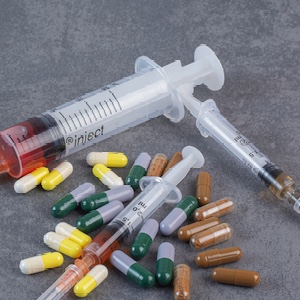Factors affecting the treatment outcome of injection based shorter MDR-TB regimen at a referral centre in India

Submitted: August 5, 2022
Accepted: September 27, 2022
Published: October 5, 2022
Accepted: September 27, 2022
Abstract Views: 1827
PDF: 493
Publisher's note
All claims expressed in this article are solely those of the authors and do not necessarily represent those of their affiliated organizations, or those of the publisher, the editors and the reviewers. Any product that may be evaluated in this article or claim that may be made by its manufacturer is not guaranteed or endorsed by the publisher.
All claims expressed in this article are solely those of the authors and do not necessarily represent those of their affiliated organizations, or those of the publisher, the editors and the reviewers. Any product that may be evaluated in this article or claim that may be made by its manufacturer is not guaranteed or endorsed by the publisher.
Similar Articles
- G. Leoncini, L. Iurilli, L. Boni, G. Blanco, P. De Bellis, G. Catrambone, Treatment of iatrogenic and traumatic tracheal disruptions , Monaldi Archives for Chest Disease: Vol. 69 No. 3 (2008): Pulmonary series
- S.M. Mirsaeidi, P. Tabarsi, M.O. Edrissian, M. Amiri, P. Farnia, S.D. Mansouri, M.R. Masjedi, A.A. Velayati, Primary multi-drug resistant tuberculosis presented as lymphadenitis in a patient without HIV infection , Monaldi Archives for Chest Disease: Vol. 61 No. 4 (2004): Pulmonary series
- Carlos A. Jiménez-Ruiz, Marcos Garcia Rueda, Manuel A. Martinez Muñiz, Jacobo Sellarés, Maria A. Jiménez-Fuentes, Lourdes Lázaro Asegurado, Esther RodrÃguez Gonzalez, Concepción Rodriguez Garcia, Oriol Armengol, Emilia Abad, Teresa Peña, Adolfo Domenech del Rio, Juan A. Riesco Miranda, Varenicline in smokers with severe or very severe COPD after 24 weeks of treatment. A descriptive analysis: VALUE study , Monaldi Archives for Chest Disease: Vol. 87 No. 3 (2017)
- Teona Avaliani, Yuliia Sereda, Hayk Davtyan, Nestani Tukvadze, Tamar Togonidze, Nana Kiria, Olga Denisiuk, Ogtay Gozalov, Sevim Ahmedov, Arax Hovhannesyan, Effectiveness and safety of fully oral modified shorter treatment regimen for multidrug-resistant tuberculosis in Georgia, 2019-2020 , Monaldi Archives for Chest Disease: Vol. 91 No. 1 (2021)
- Enrico Vizzardi, Ilaria Cavazzana, Franco Franceschini, Ivano Bonadei, Edoardo Sciatti, Carlo M Lombardi, Angela Tincani, Marco Metra, Left ventricular function in rheumatoid arthritis during anti-TNF-α treatment: a speckle tracking prospective echocardiographic study , Monaldi Archives for Chest Disease: Vol. 84 No. 1-2 (2015): Cardiac series
- Yaser Jenab, Marzieh Pourjafari, Maryam Sotoudeh, Masoumeh Lotfi-tokaldany, Nasrin Etesamifard, Shapour Shirani, Arash Jalali, Younes Nozari, Hamid-reza Poorhosseini, Comparing the effect of cardiac biomarkers on the outcome of normotensive patients with acute pulmonary embolism , Monaldi Archives for Chest Disease: Vol. 87 No. 1 (2017)
- T. Kinnunen, O. Säynäjäkangas, T. Keistinen, Features of hospitalisations for acute exacerbation of COPD resulting in death , Monaldi Archives for Chest Disease: Vol. 67 No. 1 (2007): Pulmonary series
- S.M. Mirsaeidi, P. Tabarsi, A. Mardanloo, G. Ebrahimi, M. Amiri, P. Farnia, M. Sheikhleslami, V. Bakayev, F. Mohammadi, S.D. Mansouri, M.R. Masjedi, A.A. Velayati, Pulmonary Mycobacterium Simiae infection and HTLV1 infection: an incidental co-infection or a predisposing factor? , Monaldi Archives for Chest Disease: Vol. 65 No. 2 (2006): Pulmonary series
- Neeta Singla, Amitesh Gupta, U.K. Khalid, Ravindra Kumar Dewan, Rupak Singla, Clinical profile, risk factors, disease severity, and outcome for COVID-19 disease in patients with tuberculosis on treatment under the National Tuberculosis Elimination Program: a cohort of 1400 patients , Monaldi Archives for Chest Disease: Early Access
- R. Luzzati, M. Confalonieri, A. Cazzadori, P. Della Loggia, R. Cifaldi, C. Fabris, M. Biolo, M. Borelli, C. Longo, E. Concia, Prolonged hospitalisation for immigrants and high risk patients with positive smear pulmonary tuberculosis , Monaldi Archives for Chest Disease: Vol. 75 No. 2 (2011): Pulmonary series
You may also start an advanced similarity search for this article.

 https://doi.org/10.4081/monaldi.2022.2396
https://doi.org/10.4081/monaldi.2022.2396





